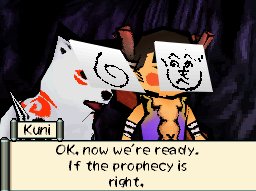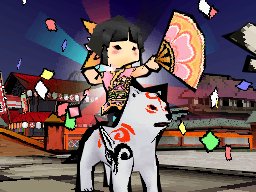Okamiden: An interview with producer Motohide Eshiro
Capcom, where do puppy gods come from?
The twilight days of the venerable DS may have already begun, but that’s not to say that there won’t be anything worthwhile coming out for the long-lived handheld now that the 3DS is set to enter the arena. Capcom’s awesome-looking Okamiden, the follow-up to their PlayStation and Wii classic and all-time GamesRadar favorite Okami(by the way, you should play Okami), is set to release on March 15. We sat down with Okamiden’s producer, Motohide Eshiro, to talk about the origins of the game, its release timing, where all of its new gameplay ideas were spawned, and just what it takes to bring back a fan favorite for another go. Some of the answers might just surprise you.
GamesRadar: The amount of fidelity to the original game, graphics-wise, is really impressive. Was that a challenge to do on the DS hardware?
Motohide Eshiro: It was pretty difficult – there’s obviously a big difference between the power of a handheld and the hardware the previous game was developed on. We had to lower the amount of polygons in the models and the amount of joints in the underlying skeleton, but we were able to utilize clever visual tracks to make things look like they have more joints than they actually do. There was a lot of experimentation involved to make it look as good as possible, given the hardware limitations. Another area we needed to adjust was sound. Since the game isn’t on a disc, we had less memory and resources to work with. It took a lot of effort on the part of our sound designers to bring things down to size for this game. The programmers also had to work hard to deal with issues like framerate. It’s tough work, but we’re pleased with the results.

GR: Was the creation of Chibiterasu a direct result of the need to scale the models down?
ME: That’s something that’s definitely worth talking about, since it’s tied to the development process. In the very very early development stages, when we first ran tests to see if the game would be even feasible to do on the DS, we used Amaterasu as the player character model. What we found out was when the camera zoomed out too much, she was really hard to see due to her ornate design. If we zoomed in too close, Amaterasu would cover too much of the background. We decided to keep the level of zoom but just tone the character model down. As we worked at it, we hit upon the idea of making the character look more childlike. We decided to go with it and make the character Amaterasu’s child, Chibiterasu. It was born of necessity, and somewhat of coincidence. From there we started thinking, if this is Amaterasu’s offspring, we can’t have them be as powerful, so we need to make up for that – what if the character worked with partners? If we’re going to have a partner, how about a whole series of partners? If we’re having so many characters, shouldn’t we give them all different abilities that will make them as formidable as Amaterasu? It all kind of started from the idea of shrinking the character.
GR: That’s really interesting. So a lot of the unique features of Okamiden are the direct result of compromising for the limitations of the hardware, in a way.
ME: Yes, Chibiterasu is a character born specifically because this game is on the DS. We do owe the Ds a debt of gratitude, in that respect. It’s something that happens a lot in game development – we owe the director a lot for this – often you start with a core idea which begins a chain reaction, and the game design will begin to blossom under its own power. That’s exactly what happened this time around.
Weekly digests, tales from the communities you love, and more

GR: The game is going to release in mid-March, around the same time as the 3DS. Are you worried that the game will be overshadowed by this new, shiny hardware launch?
ME: It is most certainly a concern – ideally, we would have liked to get this one to market earlier. But the last thing we wanted to do was compromise the localization. The story is very important to this game, and we wanted to do the best job possible. We spent a lot of time making sure elements of Japanese culture would get across and make sense to people who play it in English. We had no choice but to take our time and do that part right, and we don’t regret that. The good news is that the 3DS is backwards-compatible, so if you bought your 3DS but have trouble filling your quota of interesting games to get with it, by all means we encourage you to check out Okamiden on your new machine!
GR: So if you buy a 3DS, you should totally buy Super Street Fighter IV 3D and Okamiden.
ME: Yes. At least 2 copies of each. *laughs*

GR: A lot of people in the press feel like the original Okami didn’t really get the commercial success it deserved. Since the original title wasn’t a smash hit, what was the impetus for making a new Okami game?
ME: One thing we should probably make clear is that, while this is a new game in the Okami universe, it isn’t exactly a sequel in the traditional sense. We really want Okamiden to stand alone as an original title – obviously, it takes its cues from its mother, but we wanted to add enough new things and have it play differently enough to be its own thing. We went about that in a lot of ways, like the partner mechanic, where your partner character plays a vital role in solving puzzles and the storyline. As far as the DS as a platform, it seemed like a natural choice from both my and the director’s point of view. We both agreed that since we have a game where a key mechanic is drawing things, we wanted to but the controls literally into the players hands so they could enjoy the smooth feeling of drawing directly on the screen.
GR: Looking at it from that perspective, it might be less surprising, even though – unfortunately – the original Okami didn’t do as well as we all think it deserved to.
But despite its performance, it has a pretty fervent fanbase. As a game developer, which situation is more favorable: having a commercial mega-success that doesn’t have a big impact on individual players, or a sleeper hit that earns the love of a smaller but devout fanbase?

ME: That’s a really difficult question. I think the ideal would be to have a balance between the two. Obviously, if a character is not popular, or a game lacks any endearing personalities, it’s kind of hard to justify a sequel. You need to have a strong character. I think in the case of Okami – and in any game, really – it’s about having a character or characters that people can relate to, that will make them want to play the game. What’s also really important is timing the release such that more people will be exposed to the game. That job really falls on the producer to try and control the course of development and hit just the right timing in release, which isn’t always easy to do. Certainly, a popular character goes a long way, but timing is equally as important to get the kind of sales that you need for a game.


